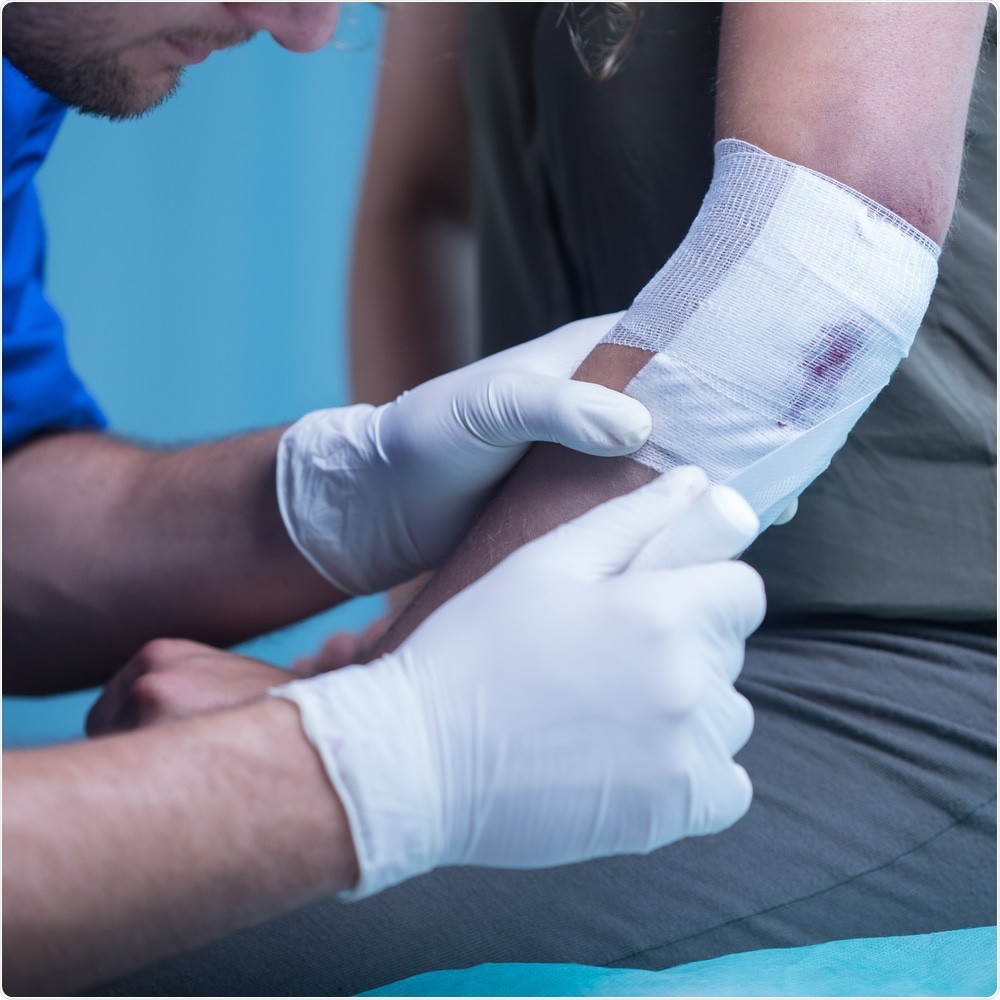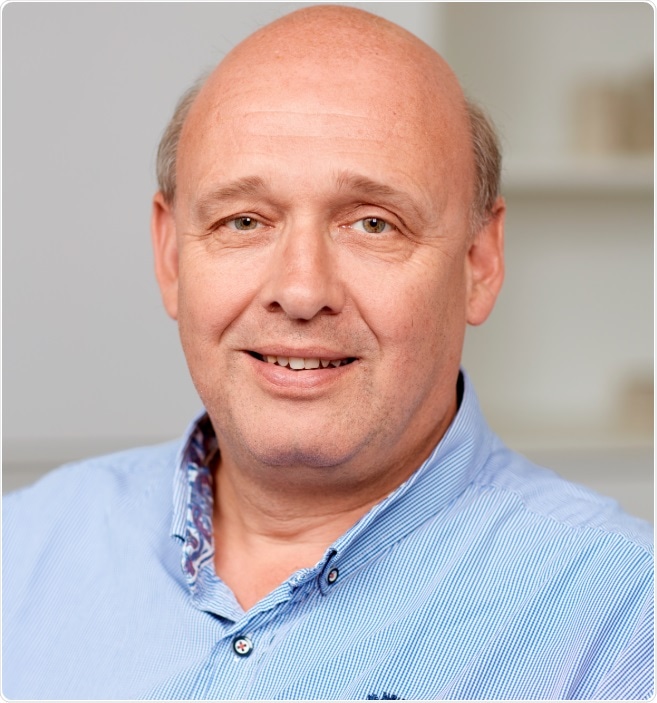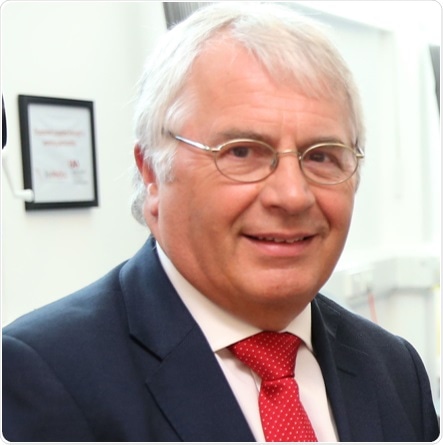An interview with Prof. Harding, CBE, and Dr Dixon, PhD, conducted by Alina Shrourou, BSC
What is a hard-to-heal wound?
There are many definitions of hard-to-heal. More conventionally, it's based on underlying etiology of the wound, but in practice it's any wound that has not healed within a timely fashion. This is often due to a lack of coordinated care. Many of those patients receive multiple courses of antibiotics and antimicrobial therapy, because clinicians aren't sure what they're looking at.
Not all wounds are necessarily hard-to-heal from the beginning, but because of the need for improvements and coordination of care, many of those patients that are seen in clinical practice become hard-to-heal.

© Photographee.eu/Shutterstock.com
How do hard-to-heal wounds contribute to antimicrobial resistance?
Many believe that you can diagnose the infection exclusively on a microbiological swab, therefore a lot of patients receive unnecessary and inappropriate antibiotic therapy. If we were to do nothing to address the current gaps in managing hard to heal wounds, the problem of antimicrobial resistance would continue to get worse, and the ability to heal wounds would become 10 times more difficult.
At the recent RCP Innovation in Medicine conference, were there any specific highlights or trends that stood out?
It was great to see that the Royal College of Physicians, a well-established organization, are very interested in wound infection. One of the big problems that we've had for years is to get recognition that wounds and problems associated with wound healing are an important clinical issue. The poster that Neem Biotech presented there was a very good example of people sitting up and taking notice that this is an important clinical problem.
What was the importance of presenting Neem's wound healing research findings?
The fact we were invited and able to present at the event is a good sign from our perspective – especially as the focus of the meeting was around innovations in medicine and we believe our approach to antimicrobial resistance and wound care in particular, is innovative.
This is the first time that we've gone out publicly in the wound space. Previously we have been active in cystic fibrosis, which is another focus of our research efforts, but through involvement with Keith and further reviews of strategy, we've now additionally focused on wound healing.
As the Royal College of Physicians is such a prestigious society and it was a 500th anniversary, it was a very high-profile event within the UK. We were fortunate to have Keith and our chief medical officer available, both of whom are physicians and members of the society.
Can you give an overview of the key findings of the work presented on Neem's poster?
Our developments have been inspired by a discovery from a natural compound, garlic, which was part of Neem's history. We are working with a novel mechanism, which is quorum sensing inhibition and is essentially the way that the bacteria communicate. When they get to a certain density of cells they start to release chemicals which communicate between the cells. This results in the production of virulence factors, of which biofilm production is a good example.
We have shown that we can affect these virulence factors, particularly the biofilm. We can affect biofilms when they're made up of mixed populations of bacteria, which is clinically relevant as this mirrors the environment you would see in the wound or in a respiratory infection.
We've shown that our approach works well in synergy with either antibiotics and/or antiseptics, which can be used as standard of care in treatment of wounds, and it has no negative impact on wound healing.
Our interest is in addressing a new and challenging aspect of wound infection in terms of quorum sensing and biofilm formation. One of the things that many of my clinical colleagues believe is that the only infected wound is either a wound that has grown bacteria, which is incorrect, or a patient who has evidence of spreading infection cellulitis or sepsis, which is also incorrect.
The work covered in our poster addresses the gaps in current understanding and clinical management of hard-to-heal wounds. It discusses the issue that many of the existing therapies that we use for infection, such as systemic antibiotics or topical antimicrobials, have limited effect when clinicians believe there may be a biofilm present. This ability to disrupt the biofilm, opens up new opportunities for us to manage a very complex, and very common and expensive clinical problem.
How have the poster findings been received by the medical and scientific communities to date?
The community in general, whether scientific or medical, have been very interested and excited by our findings because it's a novel approach to antimicrobial resistance, which as we know is a problem. It's been accepted by most of the major governments as an issue, and there's quite a bit of research funding available to try and overcome this.
We've been out in the cystic fibrosis space for a year or so, where biofilms are known to be important in respiratory infections. It's got the view of scientists, physicians, even patients in CF and some of the patient foundations. For example, we've just been awarded a UK CF Trust Innovation Award to help us to take it forward in the CF space.
Given adequate and appropriate intervention, would hard-to-heal wounds become a thing of the past?
Unfortunately, it’s unlikely that our innovations will cause hard-to-heal wounds to disappear completely because there may be many reasons why a wound is hard-to-heal. The one thing that this technology offers is an ability to intervene in wounds where infection is either the main cause, or one of the causes for a wound to become hard to heal.
What would your top tip be for policy makers, public health authorities and members of the public to ensure that hard-to-heal wounds are managed most effectively?
My tips would be to go and collect the data and realize how common and how expensive the problem is. Work that we've done in Wales has shown that 78,000 patients a year will see their GP with a diagnosis wound. That will lead to the consumption of £328 million or 6% of NHS budget. Other studies that we've done have shown that across Wales, when we surveyed eight and a half thousand patients in 66 hospitals, 30% of all hospital inpatients have a wound. We know from many studies from many countries that the current standard of care provision is poor at best.
Coordinating services, providing a comprehensive assessment, diagnosis and therapeutic intervention for patients can lead to better outcomes and even save money for healthcare systems. The advantage that we've got in Wales is that the co-location of innovative companies such as Neem and the Welsh Wound Innovation Centre provides companies, clinicians and academics with a coordinated approach to address the common and neglected problem of wounds and wound healing.
About Graham Dixon

Dr Graham Dixon is Neem Biotech’s Chief Executive Officer. He obtained a PhD in biochemistry at Swansea University and has spent over 25 years in Big Pharma, VC funded and publicly listed biotechnology companies. As Chief Scientific Officer, Graham has led over ten positive proof of concept programmes in humans and been a part of several new drug approval programmes in biotechnology companies as diverse as Onexo, Sensorion, Addex Therapeutics, Galapagos, Entomed and F2G.
In Graham’s experience, every successful programme that takes a molecule from an idea through to its embodied form in the clinic is another career highlight.
About Prof. Keith Harding

Professor Harding CBE is the Welsh Wound Innovation Centre’s Medical Director. He has worked tirelessly as a clinician, researcher and organisation head to improve the state-of-the-art in wound healing over the past three decades.
He is qualified as a medical practitioner in both general surgery and general practice and has held senior academic roles including external professorial appointments in the UK and Australia and the Dean of Clinical Innovation at Cardiff University. He has authored over 350 wound healing publications and lead several European and international expert groups and wound healing societies.
He is Editor-in-chief of the International Wound Journal and was awarded the prestigious Learned Society of Wales Fellowship in 2014.
Prof Harding has successfully raised more than £45million for wound healing service delivery and was instrumental in setting up the Welsh Wound Innovation Centre as the first dedicated wound healing centre in the world. On the back of the success of this centre, a £9 million budget was allocated by NHS Wales in 2018 to set up Innovation Centres in a number of clinical subjects using the Welsh Wound Innovation Centre model. He, along with collaborators, were also awarded £24million to create a Clinical Innovation ecosystem along the M4 corridor in South Wales in 2018.
Prof Harding was awarded a CBE in 2013 for services to Medicine and Health Care.